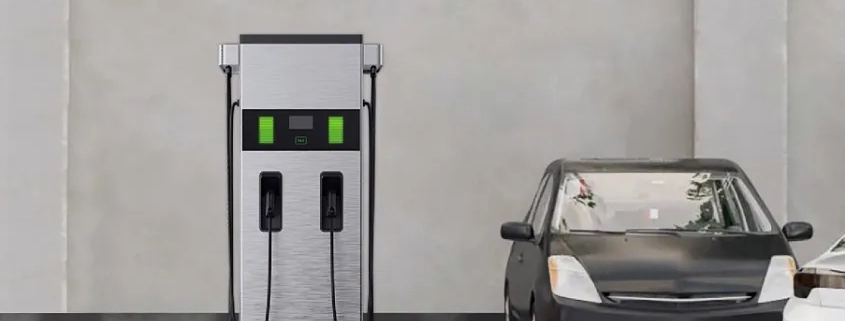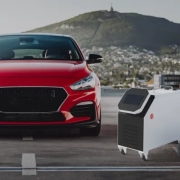Slow vs Fast EV Charging: What’s the Difference?
1. What is a slow EV charger?
Slow EV chargers are charging devices that charge at a lower power and a slower rate. The charging speed is so slow that they can’t replenish an electric vehicle quickly enough, so they are typically used for charging at home or work.
Slow chargers usually use standard household AC power and are connected through a regular electrical outlet. These chargers usually have a low power rating. A typical slow charger (level 1 portable EV charger) has a power range of 1.4-2.4kW and may take hours to tens of hours to fully charge an EV’s battery.
Slow EV chargers are suitable for charging while parked at home at night, or while parked at work (long parking times). Despite their slower charging speeds, slow EV chargers are less expensive to purchase and install, making them an affordable charging solution for everyday charging.
2. What is a Fast EV charger?
Fast EV chargers are charging devices that have higher charging power. A fast charger can charge an electric vehicle faster than a slow EV charger. These chargers are usually categorized as Level 2 or above charging devices.
Five features of fast EV chargers:
- High power output: Fast chargers typically have a high power output, often in the tens of kilowatts to 350kW range, depending on the model and specifications of the charging equipment.
- Fast charging speeds: Due to their high power output, fast chargers can charge an electric vehicle in a relatively short period. Charging speeds are typically much faster than Level 1 chargers and can fill an EV’s battery in a matter of hours, or even as little as twenty minutes.
- Scenarios: Rapid chargers are typically used for long journeys or when a quick charge is needed, such as at motorway service areas, shopping centers, car dealerships, and other locations. Australia has plans to build a fast charging station approximately every 150km on the national highways.
- Charging interface: Most fast chargers use direct current (DC) chargers. These fast chargers are compatible with the DC charging ports of electric vehicles, such as CHAdeMO, CCS, Tesla’s Supercharger, and others.
- Higher cost: Rapid chargers typically require more complex equipment and installation, resulting in higher costs. The installation of a rapid charger usually requires special electricity and equipment, such as a three-phase AC power supply. As a result, fast chargers cost more money than slow chargers that use regular household outlets.
3. What is the difference between slow charging and fast charging for electric vehicles?
-
Slow charging:
Slow charging usually refers to Level 1 charging or low-power Level 2 charging (usually in the range of 1.4 kW to 7.2 kW), where the charging speed is slower.
Slow EV chargers take hours to dozens of hours to fully charge an EV battery, making them suitable for use at home, at work, or in other locations that require long periods of parking. However, one of the most significant benefits of slow EV chargers is that they are cheaper than fast chargers. In addition to having a lower price, slow EVs don’t require a grid upgrade, making them the most affordable home charging solution.
-
Fast Chargers:
Rapid chargers usually refer to Level 2 charging stations or DC fast chargers (DCFC) with higher power output. They charge faster, typically between 7 kW and 350 kW.
The benefits of shorter charging times are obvious. When you’re in a time emergency and choose a fast DC charger with 350 kW, then that means you could be back on the road in less than 20 minutes. Yes, it takes less than 20 minutes. But the prerequisite for this outcome is that your electric car supports rapid charging.
These fast chargers are usually located at places like motorway service stations, shopping centers, and public charging stations. However, fast charging costs more to use than slow chargers due to higher power or different tariffs. There is also a concern that charging with a fast charger may produce higher temperatures and higher charging currents in the battery, which will accelerate the aging of the battery and reduce battery life.
-
Differences in charging ports for fast and slow charging:
Fast chargers usually use a DC fast charging port, such as CHAdeMO, CCS, or Tesla’s Supercharger port. However, conventional chargers usually use AC charging interfaces, such as the J1772 interface.
In summary, there are obvious differences between fast EV chargers and conventional EV chargers in terms of charging speed, applicable scenarios, charging equipment and cost, battery life impact, and charging interface.
4. Is Slow Charging Better Than Fast Charging for Batteries in Electric Cars?
Why is slow charging better for your battery than fast charging? In general perception, same as charging a mobile phone, slow charging an electric car is considered to be more beneficial to the battery than fast charging. Here are three reasons why slow charging is better for your EV battery than fast charging:
-
Less heat generation:
High temperatures can have a detrimental effect on an electric vehicle’s battery. Slow charging generates less heat, compared to fast charging, which causes more heat. High temperatures are one of the reasons why batteries tend to age. Less heat generation during slow charging helps to protect the life and performance of the battery.
-
Fewer Chemical Reactions:
Fast charging leads to a more violent chemical reaction. During rapid charging, the battery receives more power, which leads to a greater flow of ions and electrons, producing more violent chemical reactions. In addition, rapid charging causes the internal temperature of the battery to rise, which increases the rate of chemical reactions. This process is akin to using a 120w mobile phone charging cable when charging your mobile phone, and you can feel your phone getting “hot”. Experiencing this process multiple times may have a greater impact on the life and performance of the battery.
-
Extended Charging Device Life:
Slow charging causes less wear and tear on the charging device, compared to frequent fast charging, which may cause more wear and tear on the charging device.
| Feature | Slow Charging | Fast Charging |
| Charging Speed | Slow, longer charging time | Fast, shorter charging time |
| Battery Life | Helps prolong battery life | May shorten battery life |
| Convenience | Lower, longer charging time may be inconvenient | Higher, charging stations widespread, more convenient to use |
| Charging Process Impact | Minimal impact on battery, slow temperature rise | May lead to faster battery temperature rise |
5. The Difference Between Joint’s Slow and Fast Chargers.
-
EVB004 Slow Charger vs EVD100 Fast Charger
The Joint EVB004 and EVD100 chargers vary significantly in terms of features and application scenarios; with the former offering up a maximum of 22kW AC charging power suitable for home and portable usage with safety features such as temperature detection and automatic fault repair as well as charging appointment functions designed to ensure safe charging experiences.
On the other hand, the Joint EVD100 fast DC charger provides efficient and rapid DC charging at up to 180kW for commercial and fleet applications. Equipped with intelligent power-sharing technology and multiple user authentication methods for convenient user access and remote management features that ensure convenient charging services and seamless integration into cloud systems through OCPP integration, it delivers efficient fast DC charging at up to 180kW for fleet applications.
| Feature | Joint EVB04 AC Charger | Joint EVD100 Fast Charger |
| Charging Type | AC (Alternating Current) | DC (Direct Current) |
| Maximum Charging Power | 22 kW | 180 kW |
| Charging Current | Up to 32 amps | Up to 270 amps |
| Voltage Range | 220v/380v | 200V to 1000V |
| Charging Efficiency | / | > 96% |
| User Interface | / | 10-inch Touch Screen |
| Connectivity | / | LAN, Wi-Fi, 4G |
| Suitable Applications | Home use | Commercial, Fleet |
| User Authentication | / | Plug & Play / RFID / QR Code |
6. Conclusion
There are significant differences between slow and fast EV chargers, including different charging speeds, application scenarios, and impact on battery life.
Slow EV chargers run at lower power and are cost-effective for home or work charging. In contrast, fast chargers offer rapid charging, ideal for long journeys or quick charging. A comparison between Joint’s EVB 004 slow charger and EVD 100 fast charger highlights the differences between fast and slow EV chargers in real-world application scenarios, providing consumers with an informed choice based on their specific charging needs.






Leave a Reply
Want to join the discussion?Feel free to contribute!